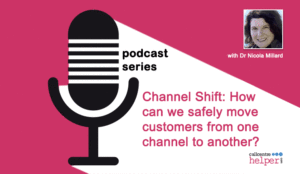Claire Lucas of Odigo introduces an approach to improving customer experience across multiple contact centre channels.
The last few years have seen an evolution in channel strategies, from multi to omni to channel-less. Diversifying communication channels is a necessary first step, but by itself is no guarantee of rewarding customer experience (CX).
The ultimate strength of a channel management strategy lies in its ability to meet customer expectations. A customer-centric perspective reveals the key differences between channel strategies, and why channel-less provides the best customer experience.
A Channel Management Strategy That Unites Conversations
Customers have more ways than ever to contact companies, with most 18-to-34-year-olds using six or more customer service channels, according to Microsoft.
But along with convenience comes a new risk, as customers’ data and requests are shared across multiple channels.
This fragmentation costs contact centre agents time and frustrates customers, three-quarters of whom expect an agent to know their contact, product and service history, according to the same Microsoft report.
For contact centres to have relevant customer information available, this data cannot be stored in separate silos.
Omnichannel, which enables cross-channel sharing of information, went a long way to fixing that. But it still falls short of customer expectations. That’s where channel-less comes in.
We are all channel-less in our private lives. A son emails his mother birthday greetings, she calls back on her mobile, and when she asks for the latest photos of his family, he follows up via social media. The channels are not important; the developing conversation is what matters.
Channel-less communication occurs when multiple communication channels are linked into one smooth conversation, making the channels used irrelevant. It’s about the message, not the medium.
To customers, the channels they’re communicating on are immaterial; their issues are what matter. The more customer-centric your channel strategy, the more important it becomes to link your channels together into one seamless experience.
Repetition: The Major Pain Point This Channel Strategy Eliminates
Channel-less CX removes one of the most frustrating pain points for customers: the need to repeat oneself.
In a study by UMB, 75% of consumers stated that they hate repeating themselves to agents; in fact, it was their number one customer service complaint (the runner-up was also telling – 73% complained about a lack of coordination between departments or cooperating companies.)
A channel strategy that requires constant reiteration defeats the purpose of hosting multiple channels – what good is a chatbot if the customer has to start over with an agent?
This is where many channel strategies run into trouble: although agents have the ability to access information on separate channels, they still have to search for it.
When a call comes in they don’t know the history, so, understandably, they ask the customer to explain the issue. They have no way of knowing how many times their customer has already told the same story.
Thus, an inadequately coordinated channel management strategy may actually harm the customer effort score (CES), resulting in a lower level of service. In contrast, a channel-less strategy instantly adds all new customer interactions into one ongoing stream, available to any agent at any time.
When a call comes in, an agent sees the customer history before the conversation even starts. Customers avoid having to repeat themselves and enjoy convenient, personalised service.
Customers Expect a Channel Management Strategy That Reflects Today’s Norms
When customers contact a company, their expectations are influenced by many factors. Not only do people notice the differences in service between similar companies, but 62% of customers say experiences in one sector influence their expectations of entirely different industries.
The best CX your customers have experienced anywhere serves as their benchmark for your service.
Customers also transfer their expectations from their personal lives. People have become accustomed to channel-less conversations with family and friends, and when that’s not possible with a company they feel disappointed with the experience. That dissatisfaction may be magnified by two additional recent developments.
First, more people are encountering multiple channels than ever before. COVID-19 changed the way millions of people do business, sending online sales up 6–10%, according to the UN.
Today 74% of customers say they’ve used multiple channels to start and complete a transaction, up from 71% in 2019.
If a channel management strategy has any gaps in it, more customers will be affected.
On top of that is a more surprising trend: customers are beginning to take their interactions with companies more personally.
Tiffani Bova, a Customer Experience Author and Podcaster, explains: “Disconnected experiences used to inconvenience customers. They still do, but they cause so much more damage in our current environment because they signal insensitivity.”
A customer who has to repeat himself doesn’t feel like he’s dealing with three channels; he feels like he’s repeating himself to one company, who won’t listen.
More customers are using more channels with higher expectations, and when something goes wrong, they’re increasingly likely to take it personally.
But while a poorly designed channel strategy is a liability, a well-managed channel strategy provides valuable opportunities to connect with customers. It saves customers time, removes hassles and pain points and shows them that their priorities come first.
Channel-less is effective because it looks at CX from the customer’s perspective. And for the customer, the experience is what matters.
Author: Guest Author
Published On: 1st Feb 2021 - Last modified: 2nd Feb 2021
Read more about - Guest Blogs, Odigo





































